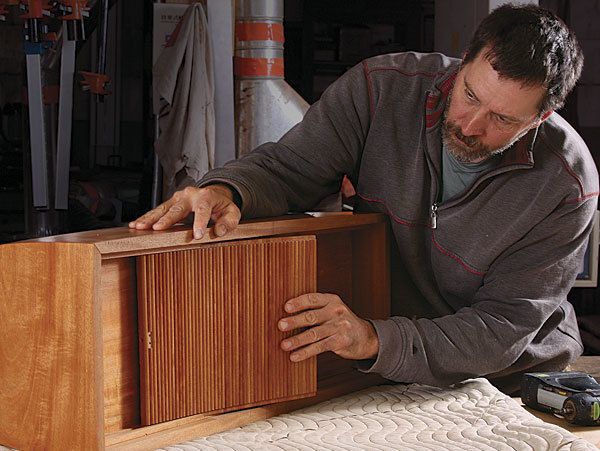Reviving the Tambour Door
Mid-century favorite goes where other doors can’t
Synopsis: Tambour doors are an elegant and easy way to close a cabinet when traditional doors won’t work, or just when you want something different. They are ideal for shallow cabinets, bowfronts, and other designs where you want different visual and tactile textures. A tambour door is made from a line of slats set snug against each other. A sheet of artist’s canvas glued to the back holds them together and acts as a hinge between the slats. The slats slide in grooves in the top and bottom of the cabinet. When you open the door, they scoot around the corner to hide between the actual side of the cabinet and a false side. Details matter, of course, but tambours are not hard to make.
There are many reasons, functional and aesthetic, to use tambour doors in a cabinet. In the old days when people had gigantic, fat TVs that they didn’t want to look at, they hid them in cabinets with pocket doors. Now, people have gigantic, thin TVs that they don’t want to look at. They want lower-profile cabinets to hide them in, and often there isn’t enough depth to the cabinet to slide in a pocket door.
Tambour doors are a sweet solution, because they slide open, wrapping around the inside of a shallow cabinet, and hide in the back. Tambours are a good option when a door that swings would be in the way. They are also an elegant and easy way to close a bowfront cabinet, since building and fitting curved doors is challenging. They are also a nice design tool. depending on whether the slats are flat or profiled, solid or veneered, tambours can give your furniture different visual and tactile textures.
A tambour door is made from a line of slats set snug against each other. A sheet of artist’s canvas glued to the back holds them together and acts as a hinge between the slats. The slats slide in grooves in the top and bottom of the cabinet. When you open the door, they scoot around the corner to hide between the actual side of the cabinet and a false side. Details matter, of course, but tambours are not hard to make.
Design and drawing
I like to design tambour doors in pairs that run in a shared groove and meet in the center of the cabinet opening. Two short doors are easier to operate and conceal than one long one. Try to avoid extreme proportions. A door that’s very tall and narrow tends to cock in its opening and bind up.
The classic tambour has bullnose profiles on its show face, similar to the ones shown here, but you can use other shapes or leave the faces flat. I make the slats between 3 ⁄8 in. and 3 ⁄4 in. wide.
I make a full-scale plan drawing of the cabinet’s interior, including all the details such as the false sides and back. I mark centerlines from front to back and side to side. I also mark out the template used to rout the door grooves, drawing a parallel line 1⁄16 in. inside the groove location. This accounts for the offset created by the router’s guide bushing.
For the full article, download the PDF below:
Fine Woodworking Recommended Products

Estwing Dead-Blow Mallet

Jorgensen 6 inch Bar Clamp Set, 4 Pack

Dubuque Clamp Works Bar Clamps - 4 pack























Log in or create an account to post a comment.
Sign up Log in